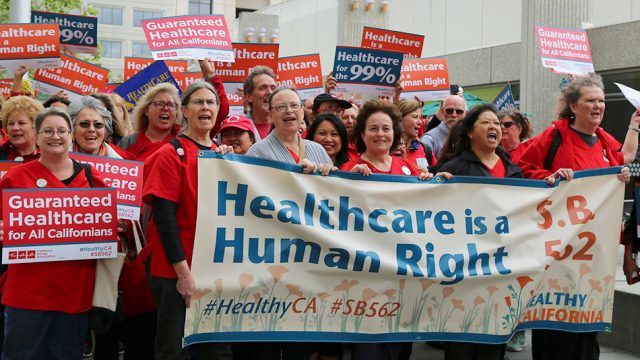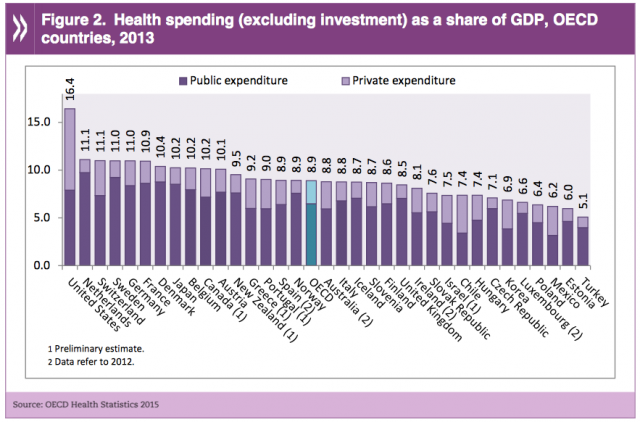The argument for single-payer health care is primarily moral. It’s just wrong to make anyone’s ability to get the health care they need dependent on their ability to pay.
Still, even when we win the moral argument, we still have to figure out how to get the system up and running – and how to fund it. It’s a sign of just how quickly the politics are moving on this in California, as the single-payer debate is increasingly about “how” and not “whether.” As will be shown below, the first analysis out of the state legislature suggests that single-payer would cost Californians just a third of what they currently spend on health care – and likely even less.
To that end, the Senate Appropriations Committee published today their fiscal analysis of Sen. Ricardo Lara’s SB 562. The headline that the media has run with is that the total cost would be $400 billion per year, and the state would need to cover about $200 billion of that cost (the other half comes from existing health care spending). Due to other savings, they conclude that “total new spending required under the bill would be between $50 and $100 billion per year.”
The analysis doesn’t make clear exactly how that sum was reached. But $400 billion is 16% of California’s overall GDP of about $2.5 trillion. That is in line with the current percentage of GDP that the United States as a whole spends on its inefficient, privatized health care system in which many people don’t get the health care that they need.
As the Senate Appropriations analysis notes, however, that $400 billion sum is about twice the amount spent in other industrialized nations. The Organization for Economic Co-operation and Development (OECD) published an analysis using 2013 numbers that showed the average percentage of GDP for health care spending in an industrialized nation is half the sum of the United States – about 8.9 percent.
Canada is a useful point of comparison, as a fellow North American economy with a population similar to that of California (36 million in Canada, 40 million in California). The OECD reports they spend about 10% of GDP on health care. In 2016, Canada’s actual sum spent was $228 billion.
So it stands to reason that a California single-payer system would be cheaper than the Senate Appropriations analysis assumes, and their figure should be considered as conservative.
But let’s say they’re right and the cost is closer to $400 billion overall, and that $100 billion in new revenues is needed (the high end of their $50b-$100b scale). That would pencil out to a monthly cost to each Californian of $208. ($100 billion / 40 million = $2500, which is the annual sum; divide that by 12 and you’re at $208.)
The average monthly premium for a Californian, as of 2016, was just under $600. For a household, it’s just above $1600.
In other words, even assuming the fiscally conservative analysis of the Senate Appropriations Committee and spreading the cost evenly across every Californian, single-payer would cost a third of what it currently costs Californians – just for health insurance alone. And unlike the present system, this would mean Californians don’t have to pay anything else beyond that $208/mo. No copays. No co-insurance. No out of pocket costs (at least within the Golden State). The ultimate savings would therefore be even greater. Californians could wind up paying just a quarter of what they pay now, if not less.
Of course, you wouldn’t actually pay for single-payer by levying just a flat fee across the state. A low-income family would pay far less in taxes than a wealthy family. The Senate Appropriations committee assumes using a 15% payroll tax to pay for single-payer, but there’s no reason we have to actually do it that way. A mixture of corporate and income taxes, especially geared toward the higher end of the scale, could bring down the cost to the median-income household even more.
Finally, the analysis notes that this would require voter approval because of the idiotic Gann Limit adopted in 1979 in the wake of the passage of Prop 13. If this does go to voters, I’d love it to be in the form of a constitutional amendment that, among other things, eliminates the Gann Limit for good.
The media will crow about the cost of single-payer. They should be emphasizing the savings. And we as activists should bring it back to the moral argument. If you can guarantee health care to every person in California as a right of being alive, and do it so for no more than a third of what people spend right now, why the hell would you say no?










You must be logged in to post a comment.